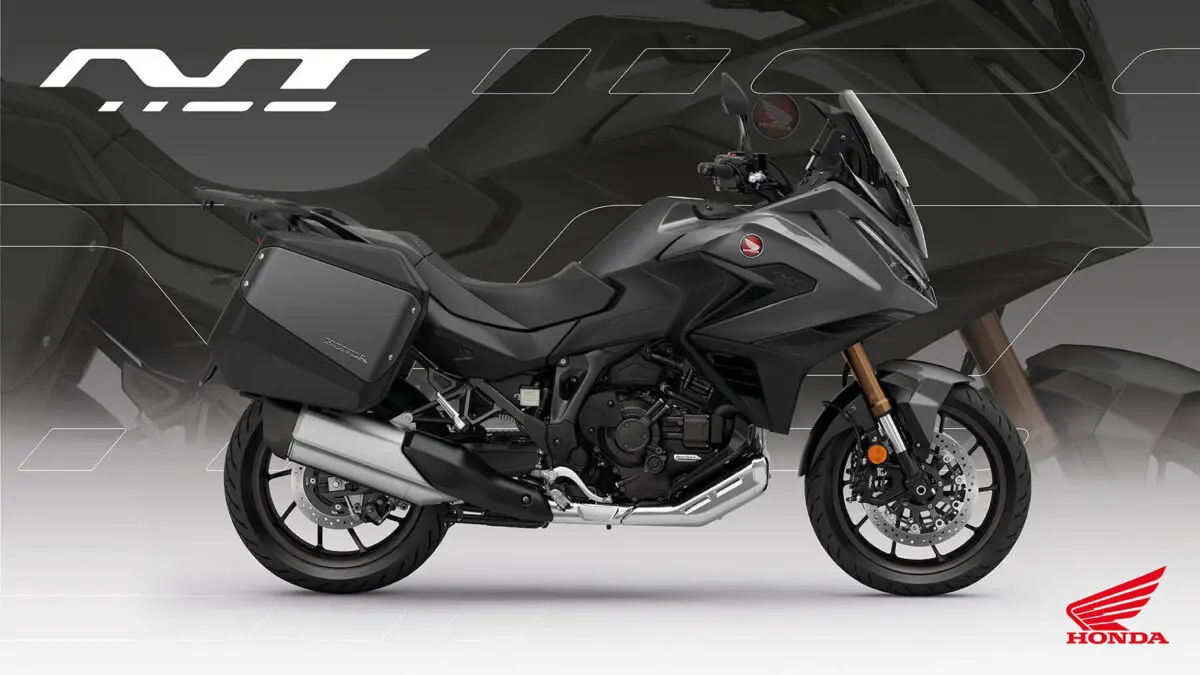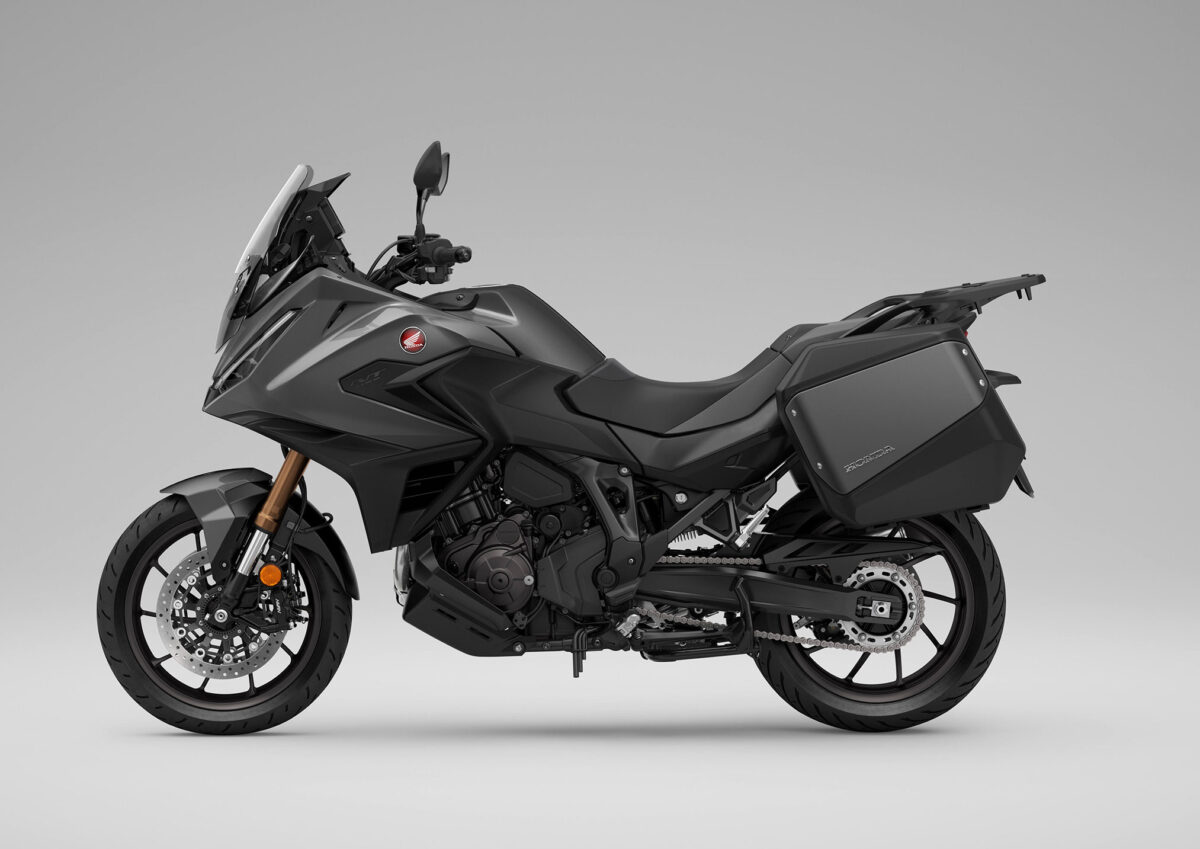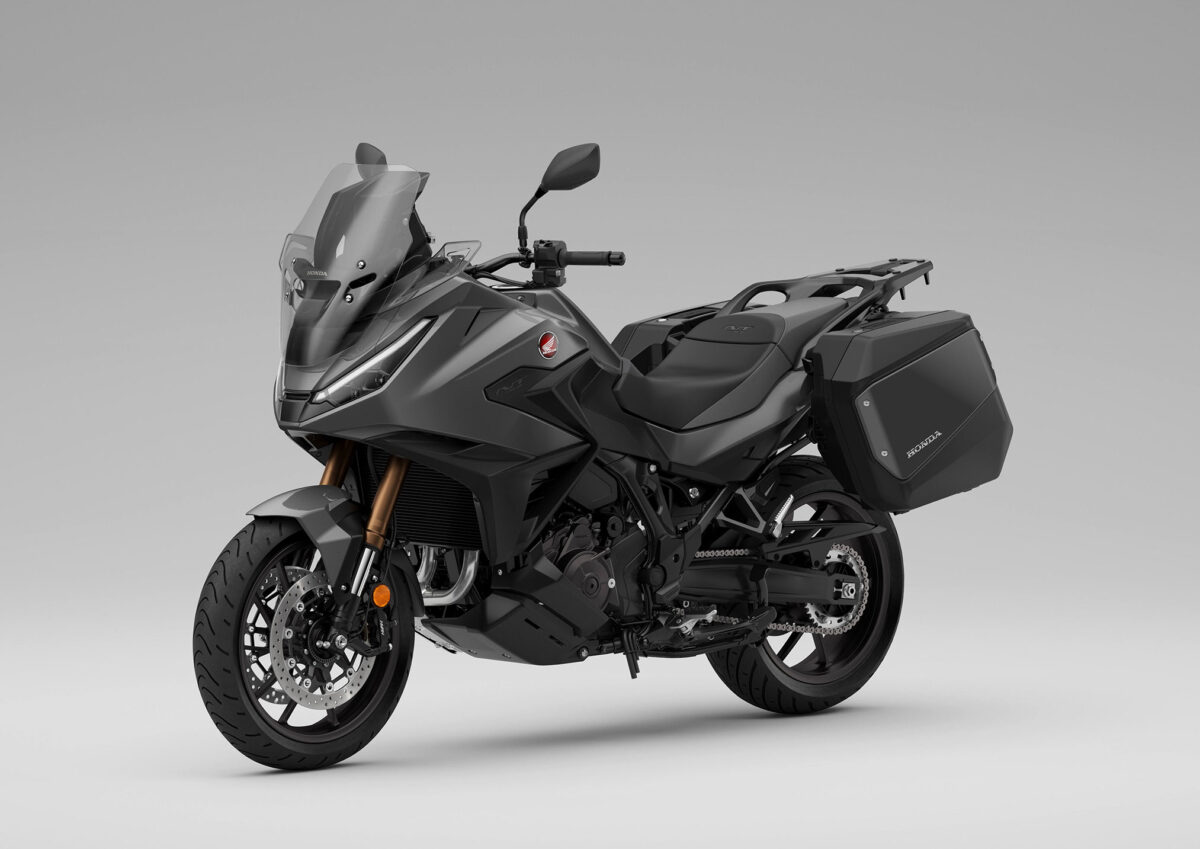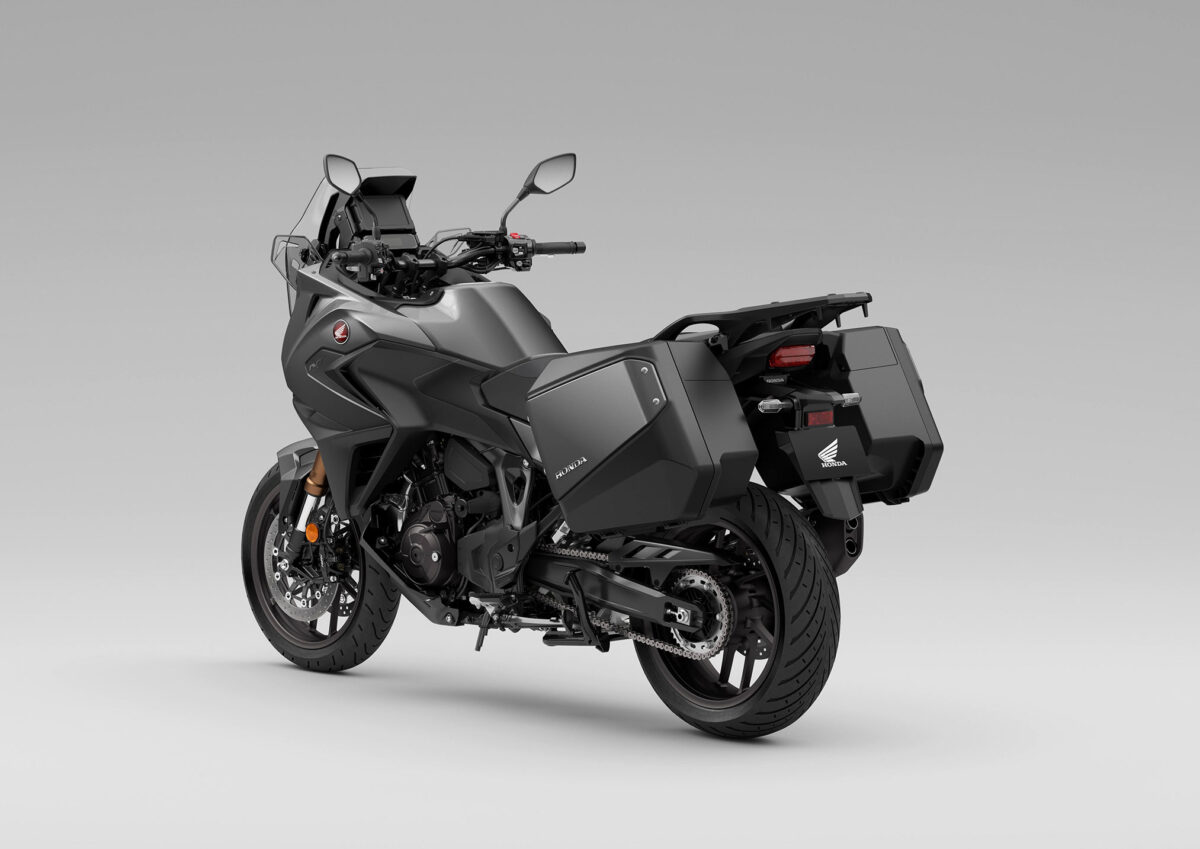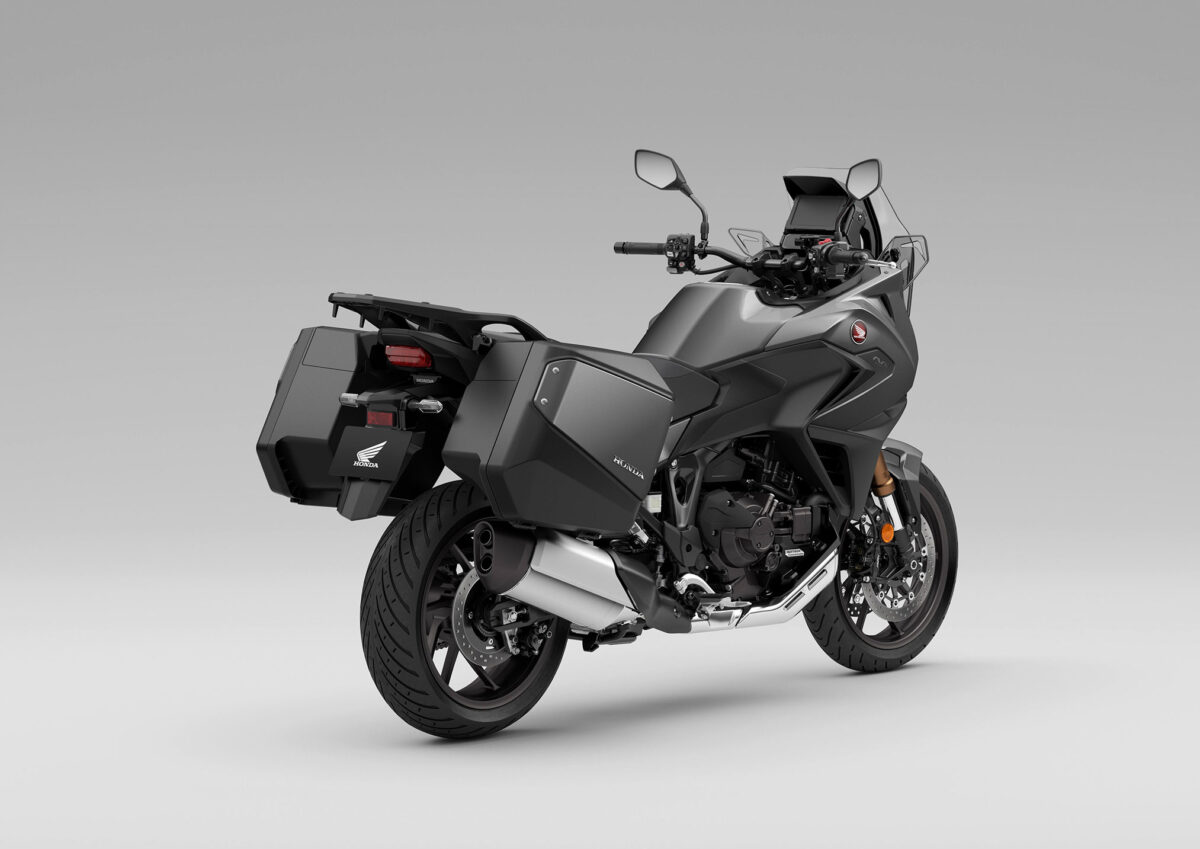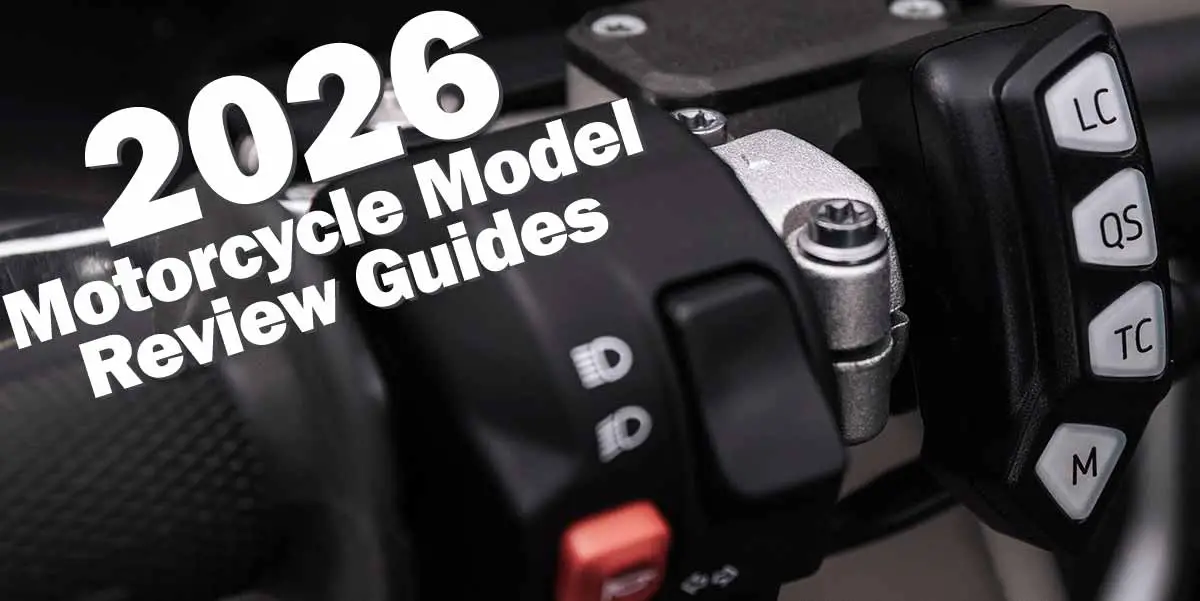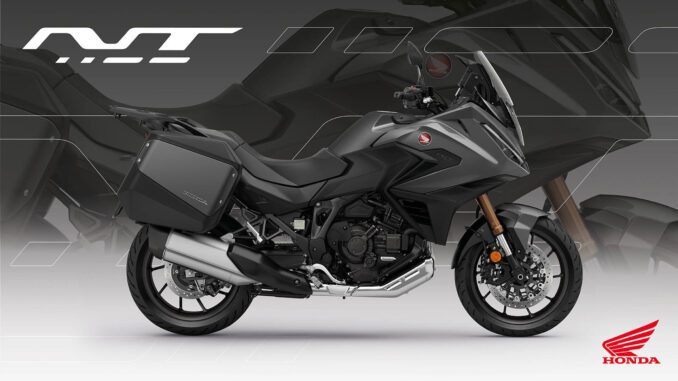
The perfect travel companion. It’s the detail upgrades that make the new NT1100 DCT Electronic Suspension such a perfect long-term travelling companion and all have been driven by the people that matter – NT1100 DCT Electronic Suspension owners.
Review – Key Features – Features & Benefits – Specifications
2026 Honda NT1100 DCT Electronic Suspension: WHAT YOU’VE BEEN WAITING FOR.
Introducing the 2026 Honda NT1100 DCT Electronic Suspension…
Electronic Suspension Upgrade
Showa Electronically Equipped Ride Adjustment (Showa-EERA) suspension is now an option. With settings specifically developed for the NT1100, the system instantly provides optimal damping force relative to stroke speed, the riding dynamic and the bike’s attitude as detected by the IMU and other sensors. It adapts in real time; during braking dive is controlled to maintain stability and the ride provided is unmatchable by a conventional setup. And Showa-EERA automatically links to riding mode selection: TOUR delivers firm damping for higher speeds, URBAN offers a mid-way balance for comfort and RAIN uses lower damping force, smoothing response and feel. Customization is possible and rear spring preload can be adjusted while on the move.
The NT1100 is a smart, sophisticated and thoroughly modern touring motorcycle. And we’ve just given it an upgrade. The twin-cylinder engine now packs more low to mid-range torque for improved acceleration. A sporty new fairing mounts the easy adjust screen and LED headlights with new DRL indicators, whilst a new Intertial Measurement Unit (IMU) control is at the heart of the updated electronic package adapting the bikes handling to the ride. The improved reaction of the optional DCT at low speeds also makes a real difference, as does the new choice of Electronic Suspension (ES) which takes the NT1100 to another place. Absolute riding perfection.
The NT1100 defined a new breed of Honda tourer when introduced as 22 year model, offering comfort, agility and hugely enjoyable performance. Building on its success, the NT received a major upgrade for 2025 with an emphasis on further increasing rider comfort. The twin-cylinder engine received a mid-range performance boost, while a six-axis IMU added extra precision to several electronic rider aids. A new variant, the NT1100 Electronic Suspension, was also added to the range that added a sophisticated ride. The NT’s sleek fairing was redrawn with sharper, more aggressive styling and topped by a revised height-adjustable screen that can now be operated one handed. The upper and lower wind deflectors were also reprofiled to ensure greater high-speed aerodynamic efficiency and outstanding weather protection. The NT1100’s lighting was also updated with twin LED headlights that integrate DRLs and indicators for increased visibility and safety. The rear of the front mudguard was extended 150mm for extra weather protection, a larger seat increased comfort and both standard-fit panniers were increased in size to offer larger internal volume. For 2026, the NT1100 and NT1100 Electronic Suspension retain all of the plus points that made them so popular across Europe and gain a new colour option, ensuring that Europe’s best-selling tourer remains at the top of its game.
In a motorcycling landscape full of adventure-focussed bikes, the last decade has seen a limited number of choices available for riders looking for performance, handling, long range comfort, and technology but not necessarily the image or physical dimensions of ‘adventure’ bikes.
The NT1100 was introduced for 2022 precisely to increase those options. It’s a straightforward touring machine, with a full feature list and a sporty edge to its performance – the sort of bike that deals with the weekday commute efficiently and is also ready for an extended tour fully loaded. Designed to draw those with a long memory of similar Honda machines of the past, but also attract a much younger rider, it employs the frame and characterful twin-cylinder engine of the CRF1100L Africa Twin as a base, ensuring characterful, engaging performance – and packs in features and technology that broaden any motorcycle’s appeal.
With this combination of wide-ranging abilities and rich specification, already over 20,000 NT1100s have been sold, and it was Europe’s most popular tourer in 2023, 2024 and 2025. For 2025 the NT1100 received major upgrades to engine performance, practicality, and long-range comfort, as well as the introduction of an Electronic Suspension option. And, in the process, cemented its place in Honda’s large range as one of motorcycling’s ultimate all-rounders.
For 2026, a new colour option for the NT1100 and NT1100 Electronic Suspension models heightens its appeal and keeps the bike fresh.
Model Overview
Comfortable, agile, enjoyable. That’s the NT1100 in a nutshell.
Its 1,084cc parallel twin cylinder engine was revised for 2025 – via intake, combustion and exhaust development – to produce 7% more low- and mid-range torque with no loss of peak power. A six-axis Inertial Measurement Unit (IMU) was also added to control not only the three-level HSTC with integrated Wheelie Control, but also Cornering ABS and Rear Lift Control. It offers three default riding modes – URBAN, RAIN, and TOUR – with preset combinations of Power and Engine Braking, plus two USER modes allowing the rider to select their own preferred permutations.
The NT1100’s sleek styling was also updated with a harder, more defined edge and refined to deliver efficient aerodynamic performance around a riding position tailored for touring. The dual headlights were reprofiled to feature a unique DRL signature with integrated indicators giving a sleeker look and increasing safety through improved visibility. The upper and lower wind deflectors were redesigned to work together to protect the rider while the adjustable screen was redesigned to be operated by the rider, one-handed, from a seated position. The seat was also redesigned to improved comfort, whilst the standard-fit panniers were increased in volume – to take a full-face helmet each – and the front mudguard was extended to offer more useful weather proofing.
2025 also saw the introduction of the NT1100 Electric Suspension variant, which features Showa Electronically Equipped Ride Adjustment (Showa-EERA) suspension. Offered alongside the standard Showa suspension-equipped ‘standard’ NT1100, the advanced Showa-EERA offers optimised damping in all riding conditions and situations, as well as the ability to adjust rear spring preload on the move.
As before, the steel semi-double cradle frame employs a relatively short wheelbase and sharp steering geometry. Dual 310mm front discs are paired with 4-piston radial-mount callipers; tires are sized 120/70-17 front and 180/55-17 rear.
A 6.5-inch TFT touch screen provides full colour, customizable displays and offers Apple CarPlay and Android Auto smartphone connectivity. Cruise control, upgraded heated grips, ACC and USB charging sockets, self-cancelling indicators and Emergency Stop Signals (ESS) are also standard fit, as is a center stand.
Honda’s proven six-speed Dual Clutch Transmission (DCT) was also updated for 2025, redeveloped to improve low-speed feel and was linked to the IMU for more intuitive gear shifting while cornering.
The 2026 refresh will see the NT1100 and NT1100 Electronic Suspension available in the following colour options:
- **NEW** Iridium Gray Metallic
- Mat Warm Ash Metallic
- Pearl Hawkseye Blue
2026 Honda NT1100 DCT Electronic Suspension Totalmotorcycle.com Key Features
- Strong mid-range power and torque for effortless touring
- Delivery, throttle response and exhaust note specific to NT1100
- Assist/slipper clutch control for manual six-speed gearbox
- Six-axis Inertial Measurement Unit (IMU) at the center of all ride systems
- Three default riding modes to choose from, plus two customizable modes
- Three level Honda Selectable Torque Control with integrated Wheelie Control
- DCT linked to six-axis IMU control for ultimate control
- Shifting schedule optimised for cornering to utilise engine torque
- Smooth low-speed response and feel
- DCT offers choice of Automatic (AT) or Manual Transmission (MT)
- Three-level S mode for wide-ranging sporty AT shifting performance
- Crisp, aggressive fairing style, topped by five-way adjustable screen that can be operated one-handed
- LED projector headlights feature DRL indicators
- Large capacity panniers accept a full-face helmet each side
- Heated grips, plus center stand, USB and ACC socket all standard equipment as well as 6.5-inch TFT screen with full smartphone connectivity
- Six-axis IMU control enables Cornering ABS to provide sure-footed braking alongside Rear Lift Control
- Option of Showa Electronically Equipped Ride Adjustment (Showa-EERA) suspension or standard Showa 43mm inverted front forks and rear shock
- Steel semi-double cradle frame and bolt-on aluminium subframe
- Dual 310mm front discs and 4-piston radial-mount callipers
Electronic Suspension
Showa-EERA suspension is now an option, optimised for a variety of riding conditions depending on the riding mode selected.
Daytime Running Lights
DRL now features integrated indicators for improved visibility to pedestrians and other road users.
Increased Luggage Capacity
Panniers fitted as standard now carry an extra 4L in each, meaning both will handily store a full-face helmet.
Adjustable Windscreen
5-level adjustable windscreen is now even easier to move whilst seated with one hand.
Six-Axis IMU
The Six-Axis Inertial Measurement Unit (IMU) expands the range of control supporting the new cornering ABS, rear tire lift control, DCT and more.
Updated Dual Clutch Transmission
A very popular option, DCT is now super-smooth at low speeds and when setting off.
The perfect travel companion
It’s the detail upgrades that make the new NT1100 such a perfect long-term travelling companion and all have been driven by the people that matter – NT1100 owners. The new dynamic front fairing wraps the rider in elegant high-speed aerodynamic efficiency, increasing wind protection and reducing fatigue. It’s also now possible to adjust the 5-level screen while seated (and stationary) with one hand. Both pannier lids are deeper so there’s more room in each, enough for a full-face helmet. And the front mudguard now extends an extra 150mm to the rear, acting as a splashguard to channel water away. The large 20L Fuel Tank delivers the freedom of long-range riding, with a potential 400km between fill-ups possible.
Performance for all occasions
When you need torque, you need torque. Especially overtaking carrying a pillion and luggage. So, the 1,084cc OHC twin-cylinder engine has 7% more torque, off the bottom and right through the middle. More mid-range power, too thanks to a higher 10.5:1 compression ratio, new crankshaft and conrods. Throttle By Wire (TBW) response has been optimised for linearity, giving smoother response to match the performance boost. The difference in acceleration, through the gears, is immediately obvious. The twin-cylinder engine is efficient too, you can cover up to 20km per litre of fuel. And the exhaust note beats out a refreshed, pulsing rhythm – the perfect backdrop to a long ride.
Updated electronics for improved handling
At the very heart of the NT1100’s superlative handling abilities is a six-axis IMU tucked away at the center of the machine that measures – in real-time – exactly what the bike is doing, as it’s doing it. This means that the 3-level Honda Selectable Torque Control (HSTC) offers newly refined rear wheel traction management as well as Wheelie Control. And, for an extra layer of riding confidence, Cornering ABS is a new addition to the electronic package. The IMU takes in lean angle, deceleration and slip rate of the front and rear wheels to manage braking pressure through the ABS. The 238kg kerb weight also makes for easy low-speed handling, and sporty feel at speed.
Increased safety with advanced rider aids
It pays to be seen, on so many levels. Of course, style matters and new dual LED projector headlights – with high/low ‘hidden eye’ design – certainly make a fearless statement that gets noticed. Sophisticated Daytime Running Lights (DRL), now with built in indicators, mark out road position highly visibly to all others ahead while self-cancelling Emergency Stop Signal (ESS) technology operates the rear indicators, alerting road users behind to a hard stop situation. And, to keep you connected while riding, the 6.5-inch TFT touchscreen features Apple CarPlay and Android Auto smartphone integration. A new Electronic Suspension variant is also available for precise response and Customization.
Electronic Suspension Upgrade. Just what you’ve been waiting for…
Showa Electronically Equipped Ride Adjustment (Showa-EERA) suspension is now an option. With settings specifically developed for the NT1100, the system instantly provides optimal damping force relative to stroke speed, the riding dynamic and the bike’s attitude as detected by the IMU and other sensors. It adapts in real time; during braking dive is controlled to maintain stability and the ride provided is unmatchable by a conventional setup. And Showa-EERA automatically links to riding mode selection: TOUR delivers firm damping for higher speeds, URBAN offers a mid-way balance for comfort and RAIN uses lower damping force, smoothing response and feel. Customization is possible and rear spring preload can be adjusted while on the move.
Set Up Perfection. Ride the way you want.
With Throttle by Wire and IMU control three default riding modes cover most situations and, alongside 3-level Honda Selectable Torque Control (HSTC), offer newly optimised ride management. URBAN delivers an all-round middle setting of engine power and braking. RAIN reduces power and engine braking for wet surfaces, while TOUR gives full engine power and standard engine braking, for strong acceleration while carrying a pillion and luggage. USER Customization is possible between power delivery, engine braking and HSTC to set the output and feel just the way you want it. Each riding mode also links to suspension response in the Showa-EERA option.
Muscular 1,084cc Twin-Cylinder Engine
A perfect blend of increased 1,084cc Twin-Cylinder engine that is tuned to accelerate and deliver plenty of power and torque for thrilling riding, both on and across the world’s terrain.
Comfortable Riding Position
And reliable, depending on the rider. Relaxed and upright — with the bars where you need them — so you can explore more forward to explore the world. The seat material has been newly improved to enhance comfort on those longer rides.
New DRL Design with Integrated Indicators
Daytime Running Lights are the new safety. With the DRL design, lighting is now much more clearly visible to other road users and pedestrians ahead.
Updated Dual Clutch Transmission (DCT)
DCT uses two clutches to deliver fast, smooth gear changes. By also reducing the chance of stalling, it makes the ride much more convenient and responsive at low speed. It’s a proven Honda system that is now even better.
Riding Equipment for Everyday and On Tour
The NT1100 is built as a long-term riding partner. Panniers, a rear rack, center stand, and ACC and USB charging sockets are all standard features. Apple CarPlay and Android Auto are also available as standard.
2026 Honda NT1100 DCT Electronic Suspension Totalmotorcycle.com Features and Benefits
Engine
A major part of the 2025 update for the NT1100 was the engine. Updated in line with the 24YM Africa Twin engine updates, performance was made much stronger in terms of mid-range power and torque, as the dyno curves proved. The 1,084cc, 8-valve parallel-twin engine now produces 75kW @ 7,500rpm with peak torque of 112Nm @ 5,500rpm, up from 105Nm @ 6,250rpm. Bore is 92mm with 81.5mm stroke; compression ratio is 10.5:1.
Throttle By Wire (TBW) provides engine management and PGM-FI feeds the throttle bodies. Throttle control – therefore drivability – has been optimised and made more linear through reduced torque fluctuation in the lower gears.
Detail changes to the engine for the 2025 update include airbox intake ducts that go from 25mm diameter to 33mm, to draw in more air, and the two internal trumpets that feed air from the airbox were made an extra 65mm longer, whilst new ECU settings and the injector angles now deliver a direct spray into the twin-spark combustion chambers.
Other changes for 2025 included a revised catalytic system to deal with the increased output. A crank pulsar – with relator teeth spaced at 10° intervals – manages misfire detection, important for OBD2/EURO5+ compliance. The additional O2 sensor, positioned at the rear of the convertor, ensures more accurate emissions measurement read outs.
Honda’s SOHC Unicam valve train and the low-set position of the cast camshaft contribute to the compact nature of the cylinder head and entire engine package; inlet valves are 36.5mm in diameter, exhaust valves 31.0mm, with 10.1mm and 9.3mm lift respectively.
Aluminium cylinder sleeves keep weight low while the 270° phased crankshaft and uneven firing interval create the engine’s signature ‘throb’. The crankshaft was also redesigned, as well as the con-rods, which feature a revised curve radius, increasing from 70 to 75R, and re-shaped and strengthened bottom end design. The pistons were made 400 micron (0.4mm) longer with revised crowns to help boost the compression ratio.
The crankcases are split horizontally; the water pump is housed efficiently within the clutch casing with a thermostat integrated into the cylinder head. Manual and DCT versions of the engine share common crankcases with only minor external differences; the water and oil pumps are both driven by the engine’s balancer shafts.
At the bottom end is a semi-dry sump with in-tank lower crankcase oil storage. This allows a lower pan depth to keep overall engine height low. As the pressure-fed pump is located within the tank where it delivers its oil from, there is no need for a pressure-feed passage. Secondary vibrations are neutralised by the mutually reciprocating motion of the pistons, while primary inertial and coupling vibrations are cancelled by use of biaxial balance shafts. The aluminium clutch center and pressure plate use ‘assist’ cams to ease upshifts and ‘slipper’ cams for deceleration and downshifting.
Engine Electronics
Throttle By Wire (TBW) management and a six-axis Inertial Measurement Unit (IMU) were at the heart of the 2025 NT1100’s electronic package overhaul. They offered up three pre-set riding modes for the rider to choose from, covering a wide variety of riding conditions and three levels of management for Power and Engine Braking, with level one delivering the maximum of either parameter. Mode selection is managed from the left-hand switchgear.
- URBAN is standard and offers an all-round middle setting of engine Power and Engine braking.
- RAIN reduces engine power and engine braking for extra reassurance on wet or slippery surfaces.
- TOUR gives full engine power and standard engine braking, for strong acceleration while carrying a pillion and luggage.
- USER 1and USER 2 modes offer the ability to customise between all the settings for the preferred combination. Once set, the USER setting is automatically stored so there’s no need to re-set each time the ignition is turned on.
There are also three levels of Honda Selectable Torque Control (HSTC) with integrated Wheelie Control – each level’s amount of intervention is optimised to work with real-time input (yaw/roll angle and rate) from the IMU. Level three provides the highest intervention. An indicator in the instrument display activates when HSTC is working; it can also be turned off completely.
Dual Clutch Transmission (DCT)
Honda has sold over 280,000 DCT-equipped motorcycles across Europe since the system first appeared as an option on the VFR1200F in 2010. Testament to its acceptance in the marketplace, since the NT1100’s introduction, 66% of customer have chosen the DCT option over the manual.
The system delivers consistent, seamless gear changes and very quickly becomes second nature in use. It uses two clutches: one for start-up and 1st, 3rd and 5th gears, the other for 2nd, 4th and 6th, with the mainshaft for each clutch located inside the other for compact packaging. Each clutch is independently controlled by its own electro-hydraulic circuit.
For the 2025 update two DCT upgrades were the target for Honda’s development engineers. First, smoother starting from standstill and control at low speed – under 10km/h – for U-turns etc. This requires a ‘quick yet gentle’ driving force at small throttle openings.
The revisions surpassed the operating parameters of the previous generation DCT by electronically estimating the oil pressure of the clutch piston chamber and renewed the way feedback gain was applied, rather than just relying on an oil pressure sensor upstream of the clutch piston. This resulted in an improved, more delicate clutch response.
Secondly, an NT1100 specific shift schedule made full use of the engine’s mid-range torque and IMU cornering detection, allowing the DCT to hold onto gears for longer while braking before downshifting to make smooth use of the drive. Similarly upshift timing was improved to match the engine’s character.
Consistent, fast and seamless gear changes are always on offer. Furthermore, as the twin clutches transfer drive from one gear to the next with minimal interruption of the drive to the rear wheel, any gear change shock and pitching of the machine is minimised, making the change feel direct as well as smooth. Extra benefits include durability (as the gears cannot be damaged by missing a gear) impossibility of stalling, low stress urban riding, reduced rider fatigue and – crucially – the ability to concentrate more on riding lines, braking and acceleration points.
The DCT system offers two distinct riding approaches – Automatic Transmission (AT), with pre-programmed shift patterns which constantly read vehicle speed, current gear and engine rpm to decide when a shift should occur, and Manual Transmission (MT), for gear changes using the paddle-shift style triggers on the left handlebar.
There are two settings within AT to choose from; D mode offers effortless riding and maximum fuel efficiency. S mode serves up 3 levels of sports-based shifting. Level 1 is the most modest, changing gears in the medium rpm range. Level 3 is the most aggressive and programmes shifts at higher rpm while Level 2 is the intermediate point between the two.
Styling & Equipment
The NT1100 was designed from the outset as a sporting, agile bike but one that’s also enjoyable to ride all day with efficient, protective aerodynamics and easy-going ergonomics all centerd around rider (and pillion) comfort. The 2025 built on these attributes; its development centerd around delivering even higher levels of comfort and practicality.
As always, the NT1100’s form is also about function, evolved with the aim of elevating the quality of the riding experience. Immediately noticeable, when compared to the 22YM design, the 2025 NT1100’s solid, three-dimensional upper fairing (now partially constructed from bio-degradable Durabio) was been recut with much more aggressive – and tightly wrapped – angles to both sides and ‘face’, matched by a svelte tail section.
The twin headlights were reprofiled to LED projectors, which incorporated Daytime Running Lights (DRLs) and subtly integrated indicators. Contrasting high/low beams express an intriguing ‘hidden eye’, whilst all other lighting is LED. Fitted as standard, upper and lower deflectors provide wind and weather protection around arms and lower body.
The screen was also completely redesigned for 2025. Following feedback from owners, riders can now raise or lower it one handed while seated on the bike. It offers five-stage adjustment for height and angle through a total of 167mm between the high and low positions. Set low, it sends air around the shoulders; set high it moves air over the rider’s helmet.
To protect both bike and rider from mud and water, the mudguard was made 150mm longer at the rear through a splash guard extension that covers the rear of the tire. The rider integrates into the machine neatly, enveloped by the protection offered by the new, reprofiled fairing.
A wide, thick seat, with optimised cushion density for comfort, offers a luxurious expanse for two; as part of the 2025 refresh the sitting area towards the rear of the rider’s seat was increased 20% over the 22YM without reducing ground reach. Seat height for the NT1100 remains 820mm and, as before, a large grabrail for the passenger extends from the rear rack.
The exhaust muffler is set low to maximise pannier volume. And it’s the standard-fit, detachable panniers that are one of the NT1100’s key features. For 2025 volume was expanded with 25mm deeper lid space (meaning the new panniers will fit the 22YM). Pannier volume is 37L left and 36L right and both panniers will hold a full-face helmet.
Bright and easy to read, the 6.5-inch TFT touch screen offers three choices of screen display; GOLD shows all numeric and mode information. SILVER centers on the speedometer and rev-counter, BRONZE on the rev-counter. The background colour can be set to black or white. Apple CarPlay, Android Auto and Bluetooth connectivity allows access to smartphone functions via the TFT display.
A high quality, weight-saving addition is use of a SKYRICH HJ13L lithium-ion battery. Contributing to mass centralisation it saved 2.5kg over the 22YM model. The premium specification is rounded out by self-cancelling indicators and Emergency Stop Signal (ESS) technology; practicality is furthered through the application of 12v and USB sockets, and a useful center stand arrangement.
Chassis
At the very heart of the NT1100 is a six-axis Inertial Measurement Unit (IMU) tucked away at the center of the machine that measures – in real-time – roll angle/ rate, pitch angle/rate and yaw angle/rate. It works through the TBW system to aid the management of rear wheel traction via Honda Selectable Torque Control (HSTC), and front wheel lift through Wheelie Control. Cornering ABS and Rear Lift Control are also integrated to the IMU to offer complete control in a variety of riding scenarios.
The IMU takes in lean angle, deceleration (from front/rear wheel speed sensors) and incorporates the slip rate of the front and rear wheels to manage braking pressure through the ABS; likewise if it detects sudden rear wheel lift, it allows fine control of brake force to maintain stability.
New for 2025 was the option of Showa Electronically Equipped Ride Adjustment (Showa-EERA) suspension on the NT1100 Electronic Suspension. Proven on the Africa Twin Adventure Sports, and with settings specifically developed for the NT1100, the system automatically provides optimum damping force relative to the stroke speed. It works by adjusting the damping level based on information from three sources: bike speed (from the ECU), the bike’s stance and attitude (from the IMU) and the fork behaviour (from the stroke sensor).
The Suspension Control Unit adjusts suspension behaviour within a mere 15 milliseconds (0.015 seconds) of these calculations being made. The system’s flexibility means that damping adjustment can be programmed to change as the vehicle speed changes – allowing firmer damping at higher speeds, for example.
In practical terms, the Showa-EERA means the rider can select all-round urban ride comfort, high speed touring stability or precise response in the rain at the touch of the meter. Showa-EERA also reduces excessive dive under hard braking.
Three pre-defined suspension modes are available:
- URBAN is the equivalent of the standard Showa suspension setup, for agile handling in a wide range of situations.
- TOUR delivers maximum braking and turning stability and the firmest damping for high speeds and two-up, fully laden touring.
- RAIN softens damping reaction to smooth and slow suspension response in wet conditions.
- USER allows a personal choice of damping and preload settings.
Showa-EERA also offers the rider the ability to adjust spring preload finely, through 24 steps, at the rear while on the move. The standard Showa setup is also available; The 43mm Showa cartridge-type inverted front forks feature 150mm travel and are preload adjustable. Like the forks, the single-tube pressurised Showa rear shock offers 150mm axle travel; it uses a 14mm diameter rod. To make carrying a pillion and/or luggage easier, spring preload adjusts hydraulically, and remotely.
The wheels are aluminium, fine diecast with a sand core allowing a hollow hub center for the front. An intersecting spoke design (with the spokes attaching to the rim diagonally) offers several benefits: it smooths road vibration in a straight line and offers high rigidity for cornering. tires are sized 120/70-17 front and 180/55-17 rear.
Wheelbase is set at 1535mm, with rake and trail of 26.5°/108mm and 175mm ground clearance. Kerb weight for the NT1100 with manual transmission is 238kg, 248kg with DCT. The Electronic Suspension options gains a further 1kg.
Dual 310mm front discs are squeezed by lightweight, 4-piston radial-mount callipers. The rear 256mm disc uses a mono-piston calliper.
Accessories
There are a range of accessories tailor made ready for the NT1100, including a quick shifter with autoblipper function, aluminium cosmetic panels for the luggage and a brand new decorative sticker set available in two colours. To make it easy for an owner to get their NT1100 the way they want it, two packs are also available (all items can also be purchased separately)
The Urban Pack has been developed to enhance the NT1100’s commuting abilities:
- Colour matching 50L Top Box with Inner Bag and Back Pad
- Alarm
The Voyage Pack builds on this further, designed to make the most of longer hauls and features:
- Colour matching 50L Top Box with Inner Bag and Back Pad
- 5L Tank Bag
- Rider/Pillion Comfort Seats
- Comfort Pillion Footpegs
- Fog Lights
2026 Honda NT1100 DCT Electronic Suspension – Totalmotorcycle.com USA Specifications/Technical Details
US MSRP Price: $ TBA USD
Canada MSRP Price: $ TBA CDN (includes Freight, PDI and Fees)
Europe/UK MSRP Price: £ See Dealer GBP (On The Road inc 20% Vat)
TBA
2026 Honda NT1100 DCT Electronic Suspension – Totalmotorcycle.com Canada Specifications/Technical Details
TBA
2026 Honda NT1100 DCT Electronic Suspension – Totalmotorcycle.com Europe Specifications/Technical Details
|
NT1100 2026 |
NT1100 DCT 2026 |
NT1100 DCT Electronic Suspension 2026 |
|
|
ENGINE |
|||
|
Engine Type |
Liquid cooled four-stroke, eight valve, parallel twin with 270° crank and uni cam |
||
|
Engine Displacement |
1,084 cc |
||
|
Bore x Stroke (mm) |
92 mm x 81.5 mm |
||
|
Compression Ratio |
10.5 |
||
|
Max. Power Output |
75.0 kW at 7,500 rpm |
||
|
Max. Torque |
112 Nm at 5,500 rpm |
||
|
Noise Level (dB) |
max. 94dB |
max. 95dB |
|
|
Max Speed |
200 km/h |
||
|
Oil Capacity |
4.8 L |
5.2 L |
|
|
Starter |
E-Starter |
||
|
FUEL SYSTEM |
|||
|
Carburation |
PGM-FI fuel injection |
||
|
Fuel Tank Capacity |
20.4L |
||
|
CO2 Emissions WMTC |
116 g/km |
||
|
Fuel Consumption |
5,0 L/100km |
||
|
ELECTRICAL SYSTEM |
|||
|
Battery Type |
Lithium-Ion |
||
|
Battery Capacity |
12 V 6.0 Ah |
||
|
DRIVETRAIN |
|||
|
Clutch Type |
Wet Multiplate Clutch |
2x wet multiplate clutch |
|
|
Transmission Type |
6-speed Manual Transmission |
6-speed Dual Clutch Transmission |
|
|
Final Drive |
Chain |
||
|
FRAME |
|||
|
Frame Type |
Semi – double cradle steel frame |
||
|
CHASSIS |
|||
|
Dimensions (L´W´H) |
2,240mm x 860mm x 1,340mm |
||
|
Wheelbase |
1,535mm |
||
|
Caster Angle |
26.5° |
||
|
Trail |
108mm |
||
|
Seat Height |
820mm |
||
|
Ground Clearance |
175mm |
||
|
Kerb Weight |
238kg +12kg Panniers |
248kg +12kg Panniers |
249kg +12kg Panniers |
|
SUSPENSION |
|||
|
Suspension Front |
SHOWA 43 mm SFF-BP type inverted telescopic fork with dial-style preload adjust, 150 mm stroke. |
SHOWA 43 mm SFF-BP type inverted telescopic fork with dial-style preload adjust, 150 mm stroke. |
SHOWA Telescopic inverted fork with an inner tube diameter of 43 mm, and an Electric controlled unit (SHOWA EERA) with compression and rebound dumping adjustments, 150 mm stroke |
|
Suspension Rear |
Monoblock aluminium swing arm with Pro-Link with SHOWA gas charged damper, hydraulic dial-style preload adjuster, 150 mm travel. |
Monoblock aluminium swing arm with Pro-Link with SHOWA gas charged damper, hydraulic dial-style preload adjuster, 150 mm travel. |
Monoblock aluminium swing arm with Pro-Link with SHOWA gas charged damper, hydraulic remote control preload adjuster and electronic control unit (SHOWA EERA) with compression and rebound damping adjustments 150 mm rear wheel travel |
|
WHEELS |
|||
|
Wheels Front |
17M/C X MT3.50 Multi-spoke cast aluminium |
||
|
Wheels Rear |
17M/C X MT5.50 Multi-spoke cast aluminium |
||
|
tires Front |
120/70ZR17 M/C (58W) |
||
|
tires Rear |
180/55ZR17 M/C (73W) |
||
|
BRAKES |
|||
|
ABS Type |
2-channel IMU based cornering ABS |
||
|
Brakes Front |
Radial mounted four-piston brake calliper, 310 mm floating double disc |
||
|
Brakes Rear |
Single piston calliper, 256 mm single disc |
||
|
INSTRUMENTS & ELECTRICS |
|||
|
Instruments |
6.5-inch TFT touch panel multi information display & LCD meter |
||
|
Headlight |
LED |
||
|
DRL |
Yes |
||
|
Taillight |
LED |
||
|
Connectivity |
Apple Car Play & Android Auto |
||
|
USB |
USB-A |
||
|
12V Socket |
Yes |
||
|
Auto Winker Cancel |
Yes |
||
|
Quick Shifter |
Optional |
– |
|
|
Security System |
HISS |
||
|
Cruise Control |
Yes |
||
|
Riding mode |
Tour, Urban, Rain, User 1 and User 2 |
||
|
HSTC with integrated Wheelie Control |
3 Level + OFF |
||
|
Rear lift control |
Yes |
||
|
Additional Features |
Screen adjustable (167 mm adjustable range) |
||
All specifications are provisional and subject to change without notice.
# Please note that the figures provided are results obtained by Honda under standardised testing conditions prescribed by WMTC. Tests are conducted on a rolling road using a standard version of the vehicle with only one rider and no additional optional equipment. Actual fuel consumption may vary depending on how you ride, how you maintain your vehicle, weather, road conditions, tire pressure, installation of accessories, cargo, rider and passenger weight, and other factors.
Manufacturer Specifications and appearance are subject to change without prior notice on Total Motorcycle (TMW).


